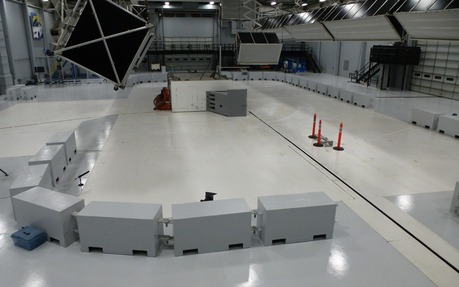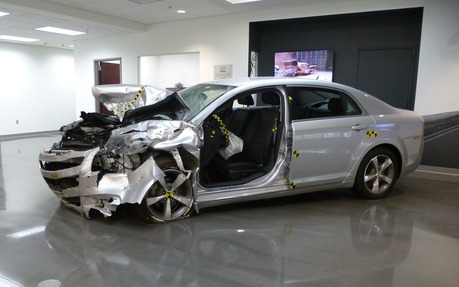Subaru Invites The Car Guide to the IIHS
Understandably proud of achieving the IIHS’ top honours since 2009, Subaru invited us to witness the controlled destruction of one of their models at the Insurance Institute for Highway Safety’s laboratory. Unfortunately, we cannot divulge the results of the test until their official unveiling. In the meantime, what we discovered at the institute is not only fascinating, but also slightly disturbing.
What is the IIHS?
Established in 1959 by a group of American insurers, IIHS originally served as a supporting body for highway safety research. Ten years later, a revised mandate turns IIHS into a research centre for active as well as passive highway safety. The first item on their new agenda, automobile bumper tests, leads to the development of the first bumper standards. Dynamic testing (crash tests) started in 1973 and demonstrated, amongst other things, the efficiency of airbags. Victory and recognition came at last in 1990 when two vehicles, both airbag equipped, crashed head-on and both drivers survived. That incident gave the IIHS the credibility they needed.
- Also: The Ford F-150 Receives IIHS' Top Safety Pick
- Also: Four More Vehicles Get IIHS Top Safety Pick+ Award
Do not confuse IIHS with NHTSA (National Highway Traffic Safety Administration). The NHTSA is an administrative division of the American Federal government tasked with establishing and enforcing standards. The NHTSA can legally compel a manufacturer to initiate a recall campaign while the IIHS’ influence the automotive industry, but have no legal powers. Both organizations are complementary.
Regardless of these differences, the IIHS testing is highly respected by carbuilders. Proving this point, new automobile designs directly address the very demanding IIHS tests in a continuous effort to obtain the highly coveted “Top Safety Pick+” award.
How does one attain this honour? It is not an easy task. Automobiles, randomly bought at dealers, must successfully pass tests involving lateral and frontal collisions, simulated roll-over and, since 2016, headlight performance. A colossal task and the reason carbuilders proudly flaunt the IIHS “Top Safety Pick+” award.

Headlights, the newest component in active safety
The IIHS is also the Highway Loss Data Institute, or HLDI. The institute recently discovered vehicles equipped with active headlights were statistically less involved in nighttime collisions. Searching for an explanation lead the IIHS to develop headlight testing. The special headlight test is now part of the complete vehicle testing procedure since 2016. It should be noted that all headlights are tested as installed by the carbuilder, the IIHS do not carry out any adjustments. Surprisingly, the majority of failed headlight tests were due to lack of proper alignment, automatically denying the carbuilder the much sought after “+” rating. Many manufacturers have since added headlight adjustment procedures on their assembly lines!
Dynamic testing requires a lot of preparation
Dynamic tests last less than one second (typically 200 to 300 milliseconds), but require a staggering amount of preparation. An army of technicians prepares the vehicle, there are up to 13 high-speed cameras, each recording 500 frames per second, installed inside the car as well as outside and sensors, computers and instruments throughout the vehicle. The cable tow line must be securely installed and checked, crash scene lighting verified and much more. To give an idea of the time required to prepare a vehicle, the IIHS conducts only two tests per week!
A live dynamic test
A loud horn announces the start of the test and everyone stands still patiently waiting at their station. An eerie silence surrounds the final 10-second countdown. Only the increasing howl of the cable tow line announces the approaching vehicle.
The car pops into sight, is released from the cable at the last second, smashes the barrier with a dull sound and skids to a stop. The speed and violence of the impact is such one hardly realizes what just happened. In no time, the technicians are busily pouring over the vehicle and only then do you start to take in the full measure of what occurred.
A Striking Testimony
While one of the younger technicians downloaded the interior video data, I could not help myself asking if working at the institute changed his driving habits. “You bet, he said. I no longer barrel through green lights and I’m far more conscious of my environment and of the other vehicles on the road.” Like it or not, you think about it.
If you think crash tests don’t serve a purpose and are really only a waste of time and money, take a minute and a half from your busy schedule and look at the video of a head-on collision between a 1959 Chevrolet Bel Air and a 2009 Malibu. The video commemorated the 50th anniversary of the IIHS and says a lot about what they asked the industry to accomplish. Their demands were high and the automobile industry responded brilliantly, significantly improving highway safety.
The Future According to the IIHS
Russ Rader, IIHS Communications Director, candidly admitted they have pretty much evaluated all there is to test insofar as collisions are concerned. The institute is currently looking more toward prevention and improving current as well as future systems. Let me conclude by quoting Mr. Rader: “The only collision you are certain to survive is the one that doesn’t occur!”
